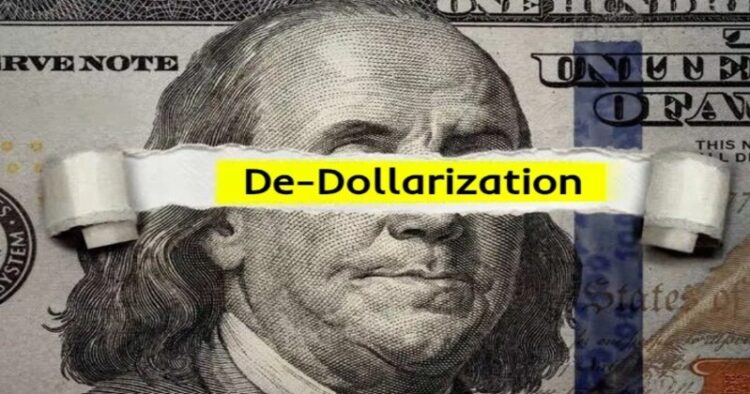BRICS, the regional partnership, comprises Brazil, Russia, India, China and South Africa. It is an emerging architecture of the multi-polar world. One of its aims is to prioritise local currencies over the established US dollar legacy.
Within this bloc, two allies, China and Russia have quite vocally reiterated and voiced their opinions about replacing the US dollar in global trade and transactions. The alliance is also convincing other developing countries to follow suit and settle payments in local currencies for cross-border transactions. BRICS’ playbook is spearheading and assembling all the players from the fringes to fill the void and help other developing nations survive without using the US dollar for trade.
Recently, it has been reported that China and Russia have sealed a trade agreement where they will use local currencies up to $260 billion. The trade deal will be initiated to settle payments in exchange for commodities purchased between the two nations. Both China and Russia will settle payments in the Chinese Yuan and the Russian Ruble, and not the US dollar. 95 per cent of the $260 billion worth of trade will be settled in the Chinese Yuan. The rest 5 per cent will be settled in the Russian Ruble and the Euro. Their anti-West, or rather, anti-US agenda, is in full symbiosis. This development has also indicated that it will be replicated in the future in other BRICS+ member countries as well.
BRICS is shedding its subservient behaviour towards US dollar led global trade. On the other hand, it will have potential implications on several financial sectors in the US leading to a market decline in the coming years.
The USD currency will return to its homeland, leading to hyperinflation in America. Furthermore, it will impact three financial sectors in the US will take a direct hit if BRICS ditches the dollar for cross-border payments. The sectors that could begin to decline include banking, foreign exchange, tourism, and consumer goods and production. The direct targeted sectors like banking and financial sectors would witness a sharp plunge of foreign exchanges.
The Biden administration should not dismiss this growing sentiment as mere renegading actions and has to swiftly recalibrate its approach. China and Russia are hell-bent to not only abate America’s so called hegemony, but to uproot its predominance in the domain of trade. This is just a tip of the iceberg.
Sanctions by the US have proven to be costly as this has provided Russia to circumvent all of the mess. China has been more than willing to help Russia. When the world is looking towards strengthening their own backyard, America’s old school tricks are failing and extending opportunities to its adversaries to leverage the vacuum which the US is unable to fill.
A recent statement made by a diplomat indicates that the BRICS 2024 summit will focus mainly on the de-dollarization agenda. This is a testament that China and Russia will most definitely endorse their concept of decimating the dominance of the US dollar, which is most definitely detrimental to the US economy.
The BRICS 2024 summit is scheduled to be held in October in the Kazan region of Russia. The 16th summit will see four new countries being a part of the meeting, including the United Arab Emirates (UAE), Egypt, Iran, and Ethiopia.
Saudi Arabia could also attend the upcoming summit if it joins the bloc, and the de-dollarization initiatives could further strengthen.The series of developments indicates that the BRICS alliance is serious. China and Russia will, by hook or crook, push the de-dollarisation agenda ahead.
This situation perhaps seems like a dilemma for India. India shares strong ties with both the US and Russia. However, India does believe in the democratisation of global trade and no monopolisation of the global currency. India, under the current regime, is a realist nation that, like any other sovereign nation, would follow the principle of self-preservation to safeguard its national aspirations and demands. India will support the ethos of this agenda, albeit to varying degrees. India needs to tread carefully to balance both extremes. Multipolarity is the essence. Therefore, it has been advocated that idea of a multi-polar world is the key to de-dollarisation, where BRICS countries will end their reliance on the US dollar. China and Russia are pretty confident. They view that the incremental de-dollarisation agenda will be successful and that the upcoming 2024 BRICS summit will achieve new heights.
If many other developing countries of the Global South commence to follow BRICS agenda, then the US dollar will be put under pressure. Therefore, the next decade will be completely different from today as local currencies could gain strength in the financial sector. The idea of de-dollarisation is not a far-fetched dream anymore. China and Russia seem to be fixated on the idea of systematically killing the demand for the US dollar through global trade.



















Comments